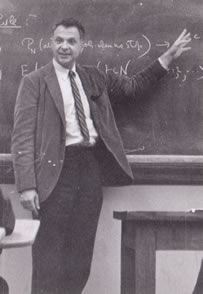Herbert Robbins
| Herbert Ellis Robbins | |
|---|---|

Herbert Robbins visiting Purdue in 1966
|
|
| Born |
January 12, 1915 New Castle, Pennsylvania |
| Died | February 12, 2001 (aged 86) Princeton, New Jersey |
| Citizenship | American |
| Nationality | American |
| Institutions |
University of North Carolina Columbia University |
| Alma mater | Harvard University |
| Thesis | On the Classification of the Maps of a 2-Complex into a Space (1938) |
| Doctoral advisor | Hassler Whitney |
| Doctoral students |
Raghu Raj Bahadur Cyrus Derman David Siegmund Herbert Wilf Gopinath Kallianpur |
Herbert Ellis Robbins (January 12, 1915 – February 12, 2001) was an American mathematician and statistician. He did research in topology, measure theory, statistics, and a variety of other fields.
He was the co-author, with Richard Courant, of What is Mathematics?, a popularization that is still (as of 2012[update]) in print. The Robbins lemma, used in empirical Bayes methods, is named after him. Robbins algebras are named after him because of a conjecture (since proved) that he posed concerning Boolean algebras. The Robbins theorem, in graph theory, is also named after him, as is the Whitney–Robbins synthesis, a tool he introduced to prove this theorem. The well-known unsolved problem of minimizing in sequential selection the expected rank of the selected item under full information, sometimes referred to as the fourth secretary problem, also bears his name: Robbins' problem (of optimal stopping).
Robbins was born in New Castle, Pennsylvania.
As an undergraduate, Robbins attended Harvard University, where Marston Morse influenced him to become interested in mathematics. Robbins received a doctorate from Harvard in 1938 under the supervision of Hassler Whitney and was an instructor at New York University from 1939 to 1941. After World War II, Robbins taught at the University of North Carolina at Chapel Hill from 1946 to 1952, where he was one of the original members of the department of mathematical statistics, then spent a year at the Institute for Advanced Study. In 1953, he became a professor of mathematical statistics at Columbia University. He retired from full-time activity at Columbia in 1985 and was then a professor at Rutgers University until his retirement in 1997. He has 567 descendants listed at the Mathematics Genealogy Project.
...
Wikipedia
